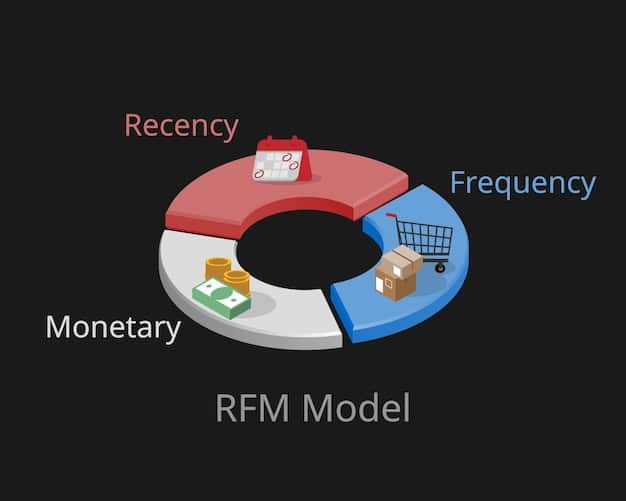2025 US Interchange Fee Changes: E-commerce Impact Guide

Proposed 2025 changes to US payment card interchange fees are poised to significantly alter operational costs, profit margins, and strategic planning for e-commerce businesses by adjusting the per-transaction expenses passed from issuing banks to merchants, potentially fostering both opportunities and challenges in a competitive digital landscape.
Understanding how the proposed 2025 changes to US payment card interchange fees will impact your e-commerce business is crucial for strategic planning and maintaining profitability. These adjustments, often overlooked until they hit the bottom line, can significantly alter the cost structure of every transaction you process. As a vital component of payment processing, interchange fees directly affect the net revenue from sales, making it imperative for online merchants to anticipate and adapt to these shifts.
Understanding Interchange Fees: The Basics for E-commerce
Interchange fees are the processing fees that a merchant’s bank (acquiring bank) pays to a customer’s bank (issuing bank) when a customer uses a credit or debit card. These fees represent the largest component of transaction processing costs for most merchants, especially those operating online. For e-commerce businesses, these fees can accumulate quickly, directly impacting profit margins on every sale.
Historically, these fees have compensated issuing banks for the risks associated with approving transactions, covering fraud prevention, and funding rewards programs. While often invisible to the consumer, they are a fundamental part of the payment ecosystem. The complexity arises from the multitude of card types, transaction methods, and card network rules, all of which influence the exact interchange rate applied.
Who Sets These Fees?
Interchange rates are primarily set by card networks like Visa and Mastercard. They publish detailed schedules that vary based on numerous factors, such as the type of card (e.g., standard, premium, business, rewards), the type of merchant (e.g., retail, e-commerce, supermarket), the transaction method (e.g., card-present, card-not-present), and even the transaction amount. These networks periodically review and propose changes to these rates, which can have ripple effects across the entire payment processing industry.
<
- Card Networks: Visa, Mastercard, Discover, American Express define the majority of interchange rates.
- Issuing Banks: Receive the bulk of the interchange fee.
- Acquiring Banks: Pay interchange fees to issuing banks, then charge merchants processing fees.
- Merchants: Ultimately bear the cost of interchange fees, which are part of their overall payment processing expenses.
The proposed 2025 changes are part of these periodic adjustments and are often influenced by market dynamics, regulatory pressures, and card network strategies to balance the interests of all participants in the payment chain. For e-commerce businesses, staying informed about these changes is not just about compliance, but about financial foresight.
Merchants typically don’t pay interchange fees directly; instead, they pay a consolidated processing fee to their payment processor, which includes interchange, network assessments, and the processor’s markup. Therefore, understanding the underlying interchange fee structure helps merchants negotiate better rates and choose suitable payment processing solutions.
Dissecting the Proposed 2025 Changes: What’s on the Table?
The upcoming 2025 changes to US payment card interchange fees are not a monolithic shift but rather a series of adjustments impacting various card types and transaction scenarios. While specific details can be intricate and vary by card network, the general thrust often aims to rebalance the cost burden, foster innovation, or address competitive landscapes.
A key area of focus often includes fees for card-not-present (CNP) transactions, which are predominant in e-commerce. Historically, CNP transactions carry higher interchange rates due to increased fraud risk. Any proposed changes in this domain could significantly affect online merchants. These adjustments might involve new categories for specific transaction types, altered rates for different card tiers, or modifications based on enhanced security protocols.
Impact on Different Card Categories
- Debit Cards: Changes here are often influenced by regulatory caps (like the Durbin Amendment for regulated debit cards). Any relaxation or tightening of these rules could lead to shifts in interchange for debit transactions. For e-commerce, this can be particularly relevant as debit cards constitute a significant portion of online payments.
- Credit Cards (Standard vs. Premium/Rewards): Rewards cards typically command higher interchange fees to fund their benefits. Proposed changes might differentiate these tiers further or introduce new incentives/penalties for specific transaction types. Businesses that process a high volume of premium card transactions might see a more pronounced impact.
- Business and Commercial Cards: These cards often have unique rate structures. Adjustments could affect B2B e-commerce platforms or businesses with a significant corporate clientele.
Moreover, card networks continuously strive to promote new technologies like tokenization and EMV 3D Secure. Interchange adjustments can be used as a lever to encourage merchant adoption of these security features, ostensibly by offering lower rates for transactions processed with higher security standards.
The proposed changes are rarely abrupt; they are usually announced with ample lead time to allow the ecosystem players to adapt. However, the sheer volume and complexity of these rate adjustments mean that merchants must pay close attention to the specifics released by Visa, Mastercard, and other networks to truly understand the potential financial implications for their unique business model.
Direct Financial Impact on E-commerce Businesses
The immediate and most tangible effect of interchange fee adjustments on e-commerce businesses will be financial. These changes directly influence the cost of accepting card payments, which in turn affects overall profitability and pricing strategies. Even seemingly small percentage point shifts can translate into significant sums when multiplied by thousands or millions of transactions.
An increase in interchange fees means a higher cost per transaction for the merchant. For businesses operating on thin margins, such as many e-commerce retailers, this can erode profits significantly. Conversely, a reduction in specific interchange categories could offer a welcome relief, freeing up capital for reinvestment or enabling more competitive pricing.

Profits and Pricing Strategies
When interchange fees rise, e-commerce businesses face a critical decision: absorb the increased costs, or pass them on to consumers. Absorbing costs can squeeze profit margins, making it harder to sustain operations or invest in growth. Passing costs to consumers, either through higher product prices or new “checkout fees,” risks alienating customers and losing competitive edge in a price-sensitive market.
- Margin Erosion: Higher interchange fees directly reduce the profit margin on each sale, especially for low-value or high-volume items.
- Pricing Adjustments: Businesses might need to re-evaluate their pricing models, potentially leading to increased product prices or the introduction of surcharges (where permitted by card network rules and local regulations).
- Competitive Disadvantage: Firms unable to absorb or effectively manage these increased costs may find themselves less competitive compared to those with better payment strategies or lower cost structures.
Furthermore, the varied nature of the changes means that the impact won’t be uniform across all businesses. A jewelry e-commerce site might be more affected by changes to premium credit card interchange, while a digital goods vendor might feel the pinch more from debit card adjustments or new micro-transaction fees. Understanding your customer’s payment behavior and the types of cards they use most frequently will be crucial in forecasting the impact.
E-commerce businesses must conduct thorough analyses of their current transaction data against the proposed new rates. This involves identifying which card types dominate their sales, existing interchange costs for those transactions, and then modeling the potential impact of the 2025 changes. This proactive financial modeling is essential for budgeting and strategic planning.
Operational and Strategic Implications for Online Retailers
Beyond the direct financial hit, the proposed 2025 interchange fee changes carry significant operational and strategic implications for e-commerce businesses. These include how payment methods are displayed, which payment processors are chosen, and even the approach to fraud prevention.
Operationally, businesses might need to re-evaluate their payment gateway configurations. If certain card categories become significantly more expensive to process, merchants might consider nudging customers towards more cost-effective payment methods. This could involve offering discounts for lower-fee options (like ACH or specific debit cards) or making those options more prominent at checkout.
Optimizing Payment Gateways and Fraud Prevention
Payment processors and gateways will also be under pressure to offer solutions that help merchants mitigate these rising costs. This could mean more granular reporting on interchange costs, tools for optimizing transaction routing, or updated fraud prevention services that directly influence interchange rates. Enhanced security measures, for instance, can qualify transactions for lower “card-not-present” interchange tiers by reducing perceived risk.
- Enhanced Fraud Tools: Investing in advanced fraud detection and prevention systems can help qualify for lower interchange rates, as card networks often offer incentives for secure transactions.
- Payment Method Prioritization: Strategically positioning lower-cost payment options at checkout (e.g., specific debit types, ACH) can subtly shift customer behavior.
- Processor Review: Regularly reviewing contracts with payment processors is vital, as their ability to negotiate or offer competitive “interchange plus” pricing structures can help cushion the impact.
From a strategic standpoint, businesses might need to reconsider their global expansion plans or target markets. If a particular region or customer demographic heavily relies on payment methods with newly increased interchange fees, the market’s attractiveness might diminish. Conversely, markets with more favorable fee structures could become more appealing.
The emphasis on data collection and analysis also grows. E-commerce businesses should leverage analytics to understand customer payment preferences, identify high-cost transaction patterns, and adapt their payment acceptance strategy accordingly. This data-driven approach is critical for staying agile in a fluctuating fee landscape and maintaining a competitive edge.
Leveraging Technology to Mitigate Interchange Fee Increases
In the face of rising interchange fees, technology emerges as a crucial ally for e-commerce businesses. Smart use of existing and emerging payment technologies can help mitigate costs, enhance security, and even improve customer experience.
One primary area is the adoption of advanced fraud prevention tools. Card networks often categorize transactions based on perceived risk, and robust fraud prevention measures can help qualify for lower “card-not-present” interchange rates. Technologies like EMV 3D Secure 2.0 (3DS2) provide richer data to issuing banks, allowing for better fraud assessment and potentially reducing interchange on authenticated transactions. Tokenization and encryption are also fundamental in securing data, reducing the scope of PCI compliance, and minimizing the risk of data breaches that could lead to costly chargebacks.
Strategic Technology Adoption for Cost Savings
- EMV 3D Secure 2.0 (3DS2): Implement 3DS2 to provide more data for authentication, potentially reducing fraud liability and qualifying for lower interchange rates.
- Tokenization and Encryption: Secure customer data effectively, minimizing fraud risk and compliance burdens.
- Payment Orchestration Platforms: Use platforms that can intelligently route transactions based on cost, performance, and fraud risk across multiple payment gateways.
- Automated Reconciliation: Streamline back-office operations to quickly identify and dispute incorrect charges or processing errors.
Another powerful technological lever is payment orchestration. These platforms allow e-commerce businesses to dynamically route transactions through the most cost-effective gateway or processor based on real-time data. This can be particularly useful when interchange fees vary significantly between different processors or for specific card types. By leveraging multiple acquiring banks or processors, businesses can optimize their payment flow to minimize overall processing costs.
Furthermore, businesses should explore alternative payment methods (APMs) that might bypass traditional card networks altogether. Options like Account-to-Account (A2A) payments, digital wallets that leverage bank transfers (e.g., Zelle in the US), or even Buy Now, Pay Later (BNPL) services can sometimes offer lower processing fees, especially for higher value transactions. Diversifying payment options not only provides cost-saving opportunities but also caters to evolving consumer preferences.
Finally, leveraging comprehensive analytics provided by modern payment platforms is key. These tools offer insights into transaction costs, chargeback rates, and customer payment behavior, enabling data-driven decisions on payment strategy and technology investments. Continuous monitoring and adaptation are essential to staying ahead in a dynamic payment landscape.
Preparing Your E-commerce Business for 2025: A Checklist
Proactive preparation is paramount when facing the upcoming interchange fee changes. E-commerce businesses that strategize early will be better positioned to minimize negative impacts and potentially even leverage new opportunities. Here’s a practical checklist to guide your readiness.
Start by conducting a thorough audit of your current payment processing expenses. Understand the various components of your fees, particularly focusing on the interchange portion. Analyze your sales data to identify the most common card types used by your customers (e.g., debit vs. credit, standard vs. premium rewards cards). This will help predict which specific interchange adjustments will affect you most directly.
Key Steps for E-commerce Preparedness
- Audit Current Payment Costs: Review statements to understand your current interchange rates and total payment processing expenses.
- Analyze Customer Payment Behavior: Identify which card types and payment methods your customers use most frequently.
- Consult with Your Processor: Discuss the proposed 2025 changes with your payment processor and understand how they plan to pass on these adjustments. Explore “interchange plus” pricing models if you’re not already on one.
- Evaluate Alternative Payment Methods (APMs): Research and consider integrating APMs like ACH or specific digital wallets that might offer lower transaction costs.
Next, engage in discussions with your current payment processor. They are your primary point of contact for these changes and should be able to provide specific details on how the new rates will be applied to your business. Inquire about “interchange plus” pricing models, which offer more transparency by separating interchange fees from the processor’s markup, allowing for clearer cost evaluation.

Consider re-evaluating your technology stack. Are you using the latest fraud prevention tools, like updated versions of 3D Secure? These security enhancements can often reduce fraud-related interchange costs. Look into payment orchestration solutions that might allow you to route transactions optimally based on cost and performance, especially if you operate with significant transaction volumes.
Finally, review your pricing strategy. While passing on costs to consumers should be a last resort to avoid customer churn, understanding the potential need for price adjustments is critical. For high-ticket items, a small percentage increase in processing fees can be absorbed, but for low-margin, high-volume products, even minor interchange hikes can necessitate strategic pricing rethink. Stay informed about industry-wide responses to maintain competitiveness.
The Long-Term Landscape: Innovation and Future-Proofing Payments
The proposed 2025 interchange fee changes are not just an isolated event but rather a continuous dynamic in the ever-evolving payment landscape. For e-commerce businesses, taking a long-term view and embracing innovation are key to future-proofing their payment strategies against ongoing shifts.
The trend towards greater transparency in payment processing, driven by merchant advocacy and regulatory scrutiny, suggests that while interchange fees may fluctuate, the demand for clearer pricing models will persist. This encourages businesses to seek out payment partners who offer transparent “interchange plus” pricing rather than bundled rates, allowing for better cost control and negotiation.
Embracing Emerging Payment Technologies
- Blockchain and Cryptocurrencies: While nascent for mainstream e-commerce, these technologies promise decentralized, lower-fee transactions in the long run.
- Request-to-Pay and Open Banking: European models for direct bank transfers could influence US markets, offering alternatives to card networks.
- Biometric Payments: Enhanced security and convenience could lead to new transaction types with potentially different fee structures.
Innovation in payment methods continues at a rapid pace. The rise of real-time payments (RTPs) and account-to-account (A2A) transfers, facilitated by initiatives like FedNow, offers a glimpse into a future where transactions might bypass traditional card networks altogether. While adoption in e-commerce for consumers is still developing, these methods could eventually provide significantly lower processing costs, redefining the payment ecosystem.
Furthermore, the focus on data and analytics will only intensify. Businesses that can effectively use payment data to understand customer behavior, optimize conversion rates, and manage fraud will gain a significant competitive advantage. This involves investing in robust analytics platforms and potentially integrating AI-driven insights to refine payment strategies continuously.
Ultimately, future-proofing an e-commerce business means building a resilient and adaptable payment infrastructure. This includes diversifying payment options, continually evaluating processing partners, adopting security best practices, and staying abreast of technological advancements. Merchants who view payment processing not merely as a cost center but as a strategic element of their business will be best equipped to thrive amidst ongoing changes.
| Key Aspect | Brief Description |
|---|---|
| 💸 Direct Cost | Changes directly impact transaction costs, affecting profit margins and potentially requiring pricing adjustments. |
| 🛡️ Fraud Measures | Enhanced security (e.g., 3DS2) can reduce interchange rates tied to fraud risk, optimizing costs. |
| 🔄 Payment Mix | Merchants may need to prioritize lower-cost payment methods or explore alternative payment systems. |
| 📊 Strategic Planning | Proactive analysis and negotiation with processors are crucial for adapting to the new fee structure. |
Frequently Asked Questions About 2025 Interchange Fee Changes
Interchange fees are charges paid by the merchant’s bank to the customer’s bank for processing card transactions. They are a primary component of payment processing costs. Card networks (like Visa and Mastercard) periodically adjust these fees to reflect market conditions, evolving payment technologies, regulatory pressures, and to fund cardholder rewards and fraud prevention efforts. The 2025 changes are part of this ongoing re-evaluation.
No, the impact will vary based on several factors. Changes might be more pronounced for businesses accepting a high volume of specific card types (e.g., premium rewards cards, debit cards) or those operating with very thin profit margins. The size of the average transaction and the merchant’s current fraud prevention measures will also influence how significantly they are affected by the new rates.
Card networks like Visa and Mastercard publish their detailed interchange fee schedules on their respective developer or partner portals. Your payment processor should also provide notifications and detailed breakdowns of how these changes will apply to your specific pricing structure. Regular communication with your processor is crucial to stay informed about upcoming adjustments and their implications.
Yes, several strategies can help. These include adopting advanced fraud prevention technologies (like 3D Secure 2.0), negotiating “interchange plus” pricing with your payment processor, optimizing transaction routing through payment orchestration, and exploring alternative payment methods (APMs) that might incur lower fees. Analyzing your transaction data to identify high-cost areas is also a vital first step.
Fraud prevention plays a significant role. Transactions deemed higher risk (e.g., card-not-present without strong authentication) often attract higher interchange rates. By implementing robust fraud detection and prevention tools, e-commerce businesses can reduce their risk profile, potentially qualifying for lower interchange tiers and fewer chargebacks, thereby lowering overall processing costs. It’s an investment that pays off.
Conclusion
The proposed 2025 changes to US payment card interchange fees represent a significant moment for e-commerce businesses. While they present potential challenges to existing cost structures and profit margins, they also underscore the need for adaptability and strategic foresight in payment processing. By understanding the intricacies of these adjustments, proactively engaging with payment processors, and leveraging technological solutions for fraud prevention and payment optimization, online retailers can navigate this evolving landscape effectively. Focusing on transparency, data-driven decisions, and the continuous evaluation of payment strategies will not only mitigate adverse impacts but also position businesses for long-term growth and resilience in a dynamic digital economy.





